
Plestiodon inexpectatus, the southeastern five-lined skink is a common skink in the southeastern United States.
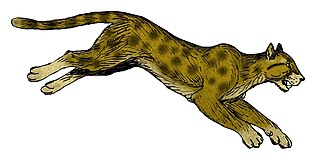
The American cheetah is either of two feline species of the extinct genus Miracinonyx, endemic to North America during the Pleistocene epoch and morphologically similar to the modern cheetah. These cats were originally known from fragments of skeletons, but nearly complete skeletons have been recovered from Natural Trap Cave in northern Wyoming.

Monochamus is a genus of longhorn beetles found throughout the world. They are commonly known as sawyer beetles or sawyers, as their larvae bore into dead or dying trees, especially conifers such as pines. They are the type genus of the Monochamini, a tribe in the huge long-horned beetle subfamily Lamiinae, but typically included in the Lamiini today.
Phrynobatrachus inexpectatus is a species of frog in the family Phrynobatrachidae. It is endemic to southern Ethiopia. It is known with confidence from only three localities, but it may be more widely distributed in the Ethiopian Highlands. The specific name inexpectatus refers to the unexpected discovery of this species among museum specimens assigned to Phrynobatrachus minutus. Common names unexpected puddle frog and Largen's dwarf puddle frog have been coined for it.

The crested roundleaf bat is a species of bat in the family Hipposideridae. It is endemic to Indonesia.
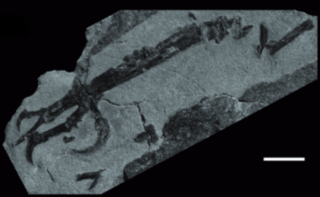
Intiornis is an extinct genus of avisaurid enantiornithean birds which existed in what is now North-West Argentina during the late Cretaceous period.

Monochamus scutellatus, commonly known as the white-spotted sawyer or spruce sawyer or spruce bug, is a common wood-boring beetle found throughout North America. It is a species native to North America.
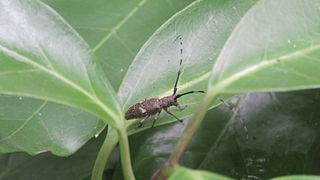
Monochamus subfasciatus is a species of beetle in the family Cerambycidae. It was described by Henry Walter Bates in 1873. It is recorded from Japan where it infests Japanese red pine and is a vector of the nematode Bursaphelenchus doui.
Monochamus adamitus is a species of beetle in the family Cerambycidae. It was described by James Thomson in 1857. It is known from Tanzania, Sierra Leone, Angola, Ghana, Mozambique, the Ivory Coast, Senegal, the Democratic Republic of the Congo, Malawi, and Zimbabwe.

Monochamus sutor is a species of beetle in the family Cerambycidae. It was described by Carl Linnaeus in 1758, originally under the genus Cerambyx. It has a wide, natural distribution throughout Europe, and has also been introduced into Belgium and the Netherlands. Adults measure between 15 to 24 mm, and larvae measure up to 45 mm (1.8 in).
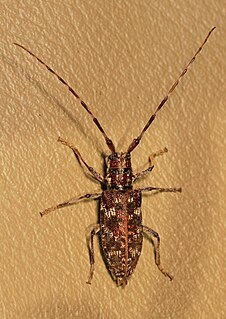
The spotted pine sawyer is a species of beetle in the family Cerambycidae. It was described by John Lawrence LeConte in 1852.

Monochamus galloprovincialis, the pine sawyer beetle, also referred to as the black pine sawyer beetle, is a species of beetle in the family Cerambycidae. It was described by Olivier in 1795, originally under the genus Cerambyx. It has a wide distribution, occurring naturally throughout Europe and the Caucasus. It has also been introduced into the Canary Islands. It serves as a vector for the parasitic nematode species Bursaphelenchus xylophilus, and also acts as a host to the parasitoid wasp species Dolichomitus tuberculatus.
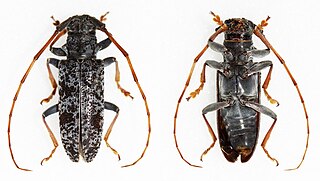
Monochamus irrorator is a species of beetle in the family Cerambycidae. It was described by Chevrolat in 1855, originally apelled as "Monohammus" irrorator. It is known from the Republic of the Congo and Nigeria.
Monochamus leuconotus is a species of beetle in the family Cerambycidae. It was described by Francis Polkinghorne Pascoe in 1869, originally under the genus Anthores. It is known from Tanzania, Cameroon, Malawi, Kenya, Mozambique, Namibia, South Africa, Uganda, the Democratic Republic of the Congo, Zambia, Angola, and Zimbabwe. It feeds on Coffea arabica.
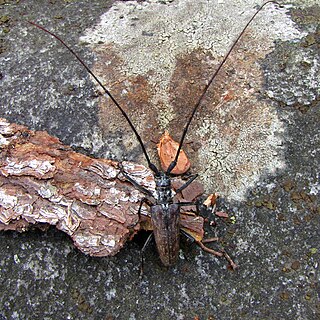
Monochamus notatus, the northeastern pine sawyer or notable sawyer, is a species of beetle in the family Cerambycidae. It was described by Dru Drury in 1773, originally under the genus Cerambyx. It is known from Canada and the United States.
Monochamus ruspator is a species of beetle in the family Cerambycidae. It was described by Johan Christian Fabricius in 1781, originally under the genus Lamia. It has a wide distribution throughout Africa.

Monochamus sartor is a species of beetle in the family Cerambycidae. It was described by Johan Christian Fabricius in 1787, originally under the genus Lamia. It is known from throughout Europe, as well as in Kazakhstan, Mongolia, North Korea and South Korea. It is rated by the IUCN as Least Concern.
Monochamus thomsoni is a species of beetle in the family Cerambycidae. It was described by Chevrolat in 1855, originally under the genus Monohammus. It has a wide distribution throughout Africa. It contains the varietas Monochamus thomsoni var. buea.
Dierogekko inexpectatus also known as Key New Caledonian Gecko is a gecko endemic to Grande Terre in New Caledonia.
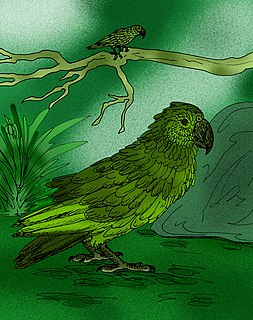
Heracles inexpectatus is a giant fossil parrot species from New Zealand, assigned to a monotypic genus Heracles, that lived during the early Miocene approximately 16 to 19 million years ago. The species was described from fossils discovered in 2008 at Saint Bathans, Otago, New Zealand. It is believed that the species stood up to 1 m tall and weighed approximately 7 kg (15 lb). Initial analysis suggests it is from the superfamily Strigopoidea, which consists of three confirmed genera of parrots: Nestor, Strigops (kakapo) and the fossil Nelepsittacus.













